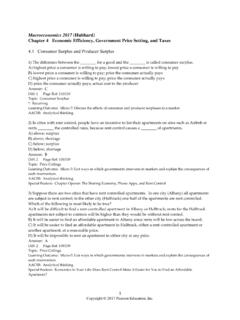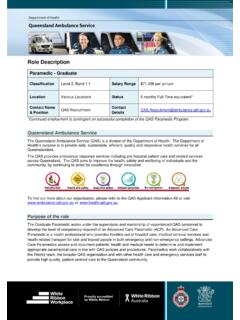Transcription of Leadership Theories and Styles - Homework For You
1 Integrative approachIncludes more than a singlevariable of theoretical study,often combining more thantwo 3 Leadership Theories andStylesIt begins with the natural feeling that one wants to serve, to serve first. Then conscious choice brings one toaspire to lead. The difference manifests itself in the care taken by the servant first to make sure that otherpeople s highest priority needs are being Robert Greenleaf1. POWER AND LEADERSHIPMatt knows history is replete with examples of leaders whose unique personality traits and charac-ter and the Leadership situations they found themselves in required them to use a variety of leader-ship Styles to influence followers in accomplishing the organizational vision and its immediate the chief executive officer, his style would be judged as good or bad based on not only the accom-plishments of his followers in achieving the desired end state of the company but also the specific stylehe chooses to adopt for the situation with which he is presented.
2 If he chooses the wrong style, he mayachieve the mission but lose credibility (referent power) as a result of the manner he used to influencethe stakeholders of the organization. Possessing good or bad Leadership character is formulated inthe eye of the beholder, and this judgment is reserved for the end of the leader-to-led process. Eachtime he asserts a particular style, he becomes a change agent to influence and affect the lives of stake-holders, be it the public, followers, subordinates, family members, or peers. In the end, the stakeholdersbecome the ultimate judges of his character and whether his Leadership style established or degradedtheir trust and confidence in his Leadership credibility (expert and referent power).
3 2. Leadership THEORIESLEARNING OBJECTIVES1. Understand personal Leadership characteristics, traits, and Define Leadership Theories that best fit your Leadership are several Theories to review in the study of Leadership . Each author conducting a study on aparticular Leadership theory provides a unique conceptualization or perspective of how Leadership isdefined in its application of theory. This section classifies Leadership Theories according to the types ofvariables that are most emphasized in a selected theoretical approach. Leadership variables are oftenclassified in terms of three characteristics namely, those of theleader,follower, and thesituation. The Key Variables in Leadership Theories sidebar identifies the key variables of each Leadership theoryand its corresponding section discusses five approaches to the study of Leadership .
4 They are the trait, behavioral,power-influence, situational, andintegrative approaches. No theoretical approach in and of itselfguarantees Leadership success. Instead, a variety of Leadership methods should be used to achieve lead-ership success. However, research explains the progress in discovering how Leadership Theories relate tothe exercise of Leadership with regard to the leader, the follower, and situational characteristics. 2018 Boston Academic Publishing, Inc., FlatWorld. All rights approachStates that leaders areendowed with superior,unique, or inherent qualities,or naturally occurringtendencies, differentiatingthem from Variables in Leadership TheoriesCharacteristics of a Leader<Traits (motives, personality)<Values, integrity, and moral development<Confidence and optimism<Skills and expertise< Leadership behavior<Influence tactics<Attributions about followers<Mental models (beliefs and assumptions)Characteristics of Followers<Traits (needs, values, self-concepts)
5 <Confidence and optimism<Skills and expertise<Attributions about the leader<Identification with the leader<Cooperation and mutual trustCharacteristics of the Situation<Type of organizational unit<Size of organizational unit<Position power and authority of leader<Task structure and complexity<Organizational culture<Environmental uncertainty and change<External dependencies and constraints<National cultural Approaches to Leadership TheoryTrait ApproachTrait approachtheories study any exceptional or distinct qualities differentiating the leader from thefollowers, with the implication that it should be possible to identify a leader based on those traits. Mostresearch in this area, beginning in the 1940s, focused on the individual traits and consequences of theleader s behavior in displaying specific traits.
6 Chapter 3 gives detailed reviews of performance evalu-ations using the Leadership Practices Inventory (LPI) as an example of looking at the combination oftraits and personalities that form a leader s character. Barnard M. Bass[1]conducted a mega study usingfifty-two organizational surveys. In reviewing these surveys, he identified trait factors that appearedthree or more times in any one organizational survey identifying a comprehensive list of traits used byorganizational leaders (see the sidebar Bernard Bass Trait Factors Appearing in Three or More Lead-ership Studies ). Also highlighted in Bass s work is whether the leader or employee possesses one ormore specific traits that lend to or detract from achieving organizational Bass Trait Factors Appearing in Three or More Leadership Studies<Technical skills<Social nearness, friendliness<Task motivation and application<Supportive of the group task<Social and interpersonal skills<Emotional balance and control< Leadership effectiveness and achievement42 THE ART OF Leadership AND SUPERVISION VERSION 2018 Boston Academic Publishing, Inc.
7 , FlatWorld. All rights reserved.<Administrative skills<General impression (halo effect)<Intellectual skills<Ascendance, dominance, decisiveness<Willingness to assume responsibility<Ethical conduct, personal integrity<Maintaining a cohesive work group<Maintaining coordination and teamwork<Ability to communicate, articulation<Physical energy<Maintaining standards of performance<Creative, independent<Conforming<Courageous, daring<Experience and activity<Nurturant behavior<Maintaining informal control of the group<Mature, cultured<Aloof, distantVideo Clip 1 Drew Dudley Everyday Leadership TED TalksThis TED Talk by Drew Dudley discusses Leadership traits in our daily the video online at.
8 3 Leadership Theories AND STYLES43 2018 Boston Academic Publishing, Inc., FlatWorld. All rights approachThis theoretical approachfocuses on the leader sobservable behaviors thatinfluence followers tocommit their actions to meetthe specified taskrequirement of the theory stipulates theleader s behavior is the cuethat evokes the followers actions to accomplish a taskor behave in a theoryThe leader reinforces changein a follower or subordinateby providing or showing thefollower the path to therewards accomplishment of oneor more activities or things,usually over a period of time,in stages, or with thepossibility of repetition,including major activitiesleaders perform in the areasof influencing, operating.
9 ApproachStudies influence processesbetween leaders and is a leader-centeredperspective that proposesthat causality occurs whenthe leaders direct and thefollowers act on the ApproachA way to better understand thebehavioral approachinvolves an understanding of thepath-goaltheory[2]in terms of the operant conditioning of the follower to perform a required task or behave in acertain manner. An example of the path-goal theory is when the leader reinforces the desired changebehavior in a follower or subordinate by demonstrating what reward is available to him or her. Theleader shows the follower the paths (behaviors) through which the reward may be obtained. The fo-cus of this particular theoretical approach is on the leader s observable behaviors (actions) that in-fluence followers to commit theiractionsto meet the specified task requirement of the path-goal theory stipulates the leader s behavior is the operant condition cue that evokes thefollower s actions to accomplish a task or behave in the desired manner the leader is seeking.
10 The cueoften begins with the leader communicating (written or verbal) an organizational task with a purpose,such as when a leader directs a follower to complete a report (task) in order to assess the number ofcustomer uses per type of service (purpose). The leader is performing (behaving) his or her role by eli-citing a cue to the follower to begin accomplishing a task. The desired follower s behavior to completethe report and meet the purpose of the task is in response to the leader s initial behavioral cue. The fol-lower s actions to accomplish the task can act as a positive or negative consequence for the leader, rein-forcing other actions from the leader that are dependent on the follower succeeding or failing at thetask.












